
Dec '20
The IUP Journal of Case Folio
Archives
Amazon.com, Inc.: Tackling Challenges and Building Resilience Amidst the Covid-19 Pandemic
Hadiya Faheem
Freelancer, Hyderabad, Telangana, India. E-mail: research@icmrindia.org
Debapratim Purkayastha
Director, IBS Case Research Center, IBS Hyderabad (Under IFHE ? A Deemed to be University u/s 3 of the UGC Act, 1956), Hyderabad, Telangana, India. E-mail: debapratim@ibsindia.org
The case discusses American multinational conglomerate and technology company Amazon.com, Inc.?s strategy to survive and emerge successfully from the Covid-19 or Coronavirus pandemic. The Covid-19 outbreak that started in December 2019 in Wuhan, China, soon spread to countries across the world, and led to consumers and businesses taking precautions to prevent transmission of the disease. Many were forced to stay indoors. While this affected many industries, Amazon experienced a surge in orders for delivery, with consumers spending $11,000 every second on buying products or services on the company?s e-commerce platform. Analysts felt that Amazon, which was already a hit with consumers doing shopping online and which controlled 40% of all the online retail sales in the US, as of March 2020, was better positioned to tackle the crisis due to its e-commerce prowess and its cloud computing arm, Amazon Web Services (AWS). Though the initial months of the pandemic led to sales increase due to a spike in demand, the retailer was facing issues with delivery fulfilment. Product delivery was taking weeks or even months due to a surge in demand resulting from panic buying by consumers. The company was also facing issues with its supply chain. Amazon and its founder, Jeff Bezos, also attracted the ire of its warehouse workers who alleged that the company was putting their safety at risk by continuing operations. They alleged that Amazon was not being transparent about the Covid-19 cases in its facilities and that it was slow to provide them with Personal Protective Equipment (PPE). Some of the workers complained that the retailer was risking their lives, forcing them to work during the pandemic in a bid to keep its stores running when most people were being asked to stay indoors. The retailer was also criticized by the US Senators for firing whistleblowers who had raised concerns over warehouse conditions during the pandemic. With these being early days of the pandemic, some analysts opined that it could be a tough road ahead for Amazon as the company would have to grapple with the full impact of the Covid-19 pandemic. .
From online shopping to AWS to Prime Video and Fire Tv, the current crisis is demonstrating the adaptability and durability of Amazon?s business as never before, but it?s also the hardest time we?ve ever faced.1
- Jeff Bezos, Founder and CEO of Amazon.com, Inc., in May 2020.
During this crisis, Amazon has proven irreplaceable in delivering the daily necessities to people around the world, a fact that we believe will increase the number of customers on the platform, expand the list of products purchased by existing customers, accelerate the shift to e-commerce at large and enhance the company?s brand.2
- Brian Whit, Analyst at Monness, Crespi, Hardt & Co., Inc.a, in April 2020.
On May 1, 2020, American multinational conglomerate and technology company Amazon.com, Inc. (Amazon) reported that for the first quarter ended April 30, 2020, it had recorded revenue of $754 bn (see Exhibit I for Amazon?s Consolidated Statement of Operations for first quarter of 2020). The e-commerce giant reported a 26% increase in sales from the same period of 2019.3 The increase was attributed to the novel Covid-19
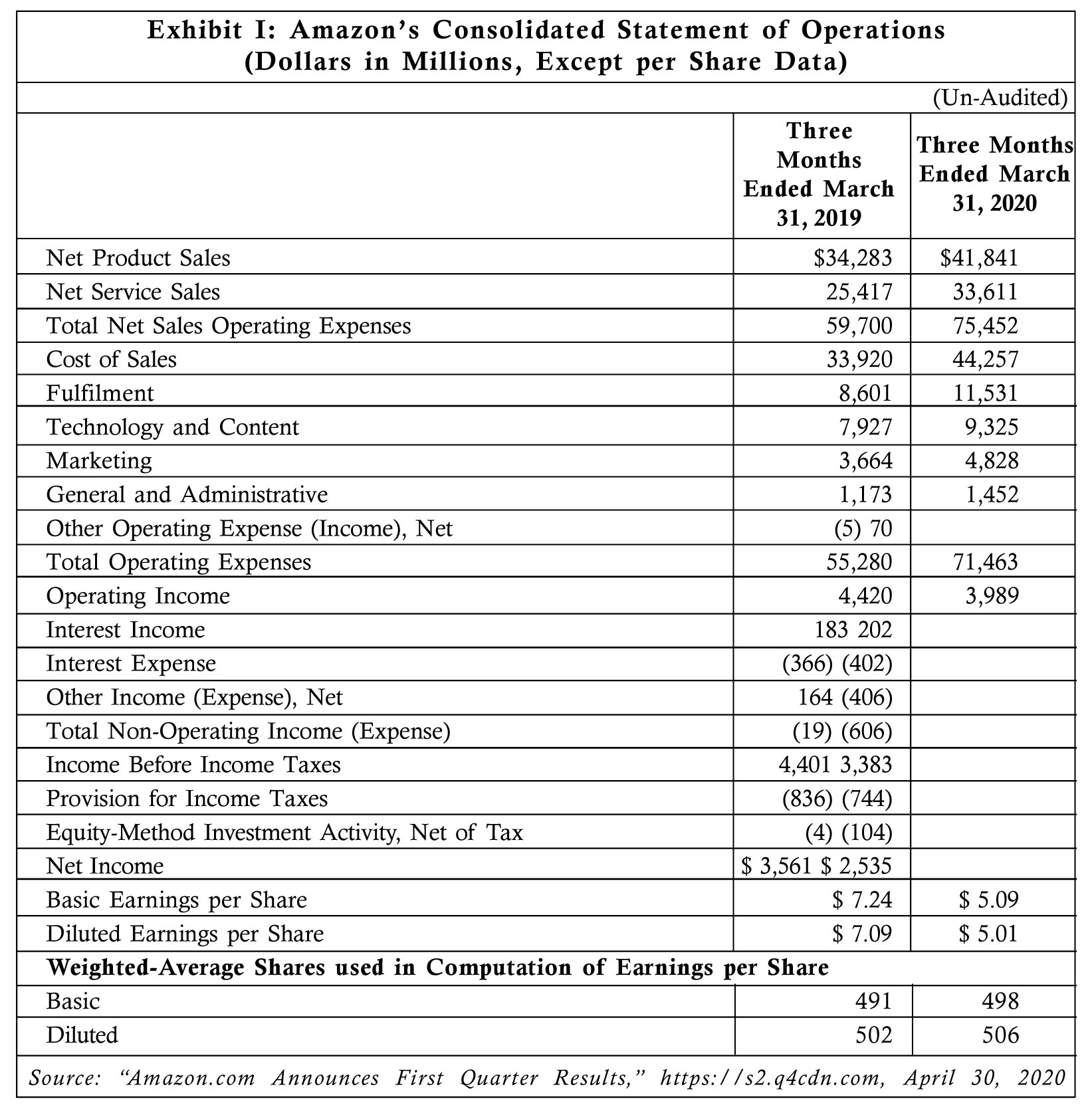
pandemic that had forced hundreds of millions of people stuck in lockdowns to remain indoors and turn to the retailer for their essentials and entertainment.
The Covid-19 outbreak started in December 2019 in Wuhan, China. With awareness about the virus increasing, consumers began taking precautions to prevent transmission of the disease. As there was no cure or established treatment for the infection in sight, people in many countries were forced to stay indoors. While this affected several industries such as restaurant, travel and retail, Amazon experienced a surge in orders for delivery with consumers spending $11,000 every second on buying products or services on the company's e-commerce platform.4
Analysts felt that Amazon, which was already a hit with consumers doing shopping online and which controlled 40% of all the online retail sales in the US as of March 2020, was in a good position to tackle the crisis due to its e-commerce prowess and its cloud computingb arm, Amazon Web Servicesc (AWS).5 According to Wedbush Securitiesd analyst Michael Pachter, for the month of March 2020, Amazon orders had increased from 10% to 12% in the US as more and more consumers were buying products online due the pandemic, boosting the e-commerce giant's revenue by an additional $800 mn per month.6
However, Amazon faced issues with delivery fulfilment. Product delivery was taking weeks or even months as there was a sudden surge in demand due to panic buying by the consumers. To combat the challenge of fulfilling deliveries, Amazon hired 175,000 workers to cater to the increasing demand from consumers.7 The company also faced issues with its supply chain. While Amazon was grappling with the surge in online orders, Amazon and its founder and CEO Jeff Bezos (Bezos) came under intense scrutiny after worried warehouse workers alleged that the e-commerce giant was not being transparent about the Covid-19 cases in its facilities and was slow in providing them with Personal Protective Equipment (PPE). The workers complained that the retailer was putting their lives at risk by forcing them to work during the pandemic in a bid to keep its warehouses and stores running when most people were being asked to stay indoors. The retailer was also criticized by the US senators for allegedly firing whistleblowers who had raised concerns over warehouse conditions during the pandemic.
Despite several challenges, some analysts felt that Amazon was picking up more subscribers during the pandemic, leading to it garnering huge sales. On the other hand, some critics opined that it could be a tough road ahead for Amazon as the company would have to grapple with the full impact of the Covid-19 pandemic. Going forward, how should Bezos and his team go about tackling the challenges and building resilience amidst the accelerating Covid-19 pandemic? What should Amazon do to offer its services to customers in the convenient, predictable and timely fashion it was known for? How should the company balance the need for providing essentials to customers with the need to keep its workers and customers safe? What should Bezos and the senior management team at Amazon do to mitigate supply chain disruptions and build supply chain resilience amidst the pandemic?
Background Note
Amazon, founded by Bezos in 1994, started as an online bookstore. In 1997, it went public and was valued at $300 mn. In 1998, it began selling music DVDs or videos. The music section started with 125,000 titles. In 1999, the company started the sales of home-improvement products, software, video games and gift items.8
In 2000, Amazon started its operations for the first time abroad ? in Japan. In 2002, it took advantage of its infrastructure investment by venturing into cloud computinge with the unveiling of AWS. The same year, it started selling apparel online. The following year, the company started selling health and personal care products, gourmet foods, and sporting and outdoor goods. It also launched an electronics store.
In 2005, the company launched Amazon Prime, a membership scheme that offered free two-day shipping on any order for an annual fee.f As of October 2018, Prime had over 100 million members globally. Amazon went on to introduce one-day delivery, same-day delivery, and even two-hour delivery in certain locations. The popularity of the Prime service could be gauged from the fact that the company shipped more than five billion products globally through Prime in 2017. Free shipping was also expanded to all customers on certain occasions like the holiday season with no minimum purchase amount on orders.
In 2006, the retailer started a service called Fulfilment by Amazon (FBA) where it handled back-end operations such as storage, fulfilment and customer service of third-party sellers. The third-party sellers shipped their inventory to Amazon and the retailer then managed the complete back-end fulfilment of an item once it was purchased. By using the FBA service, the third-party sellers could differentiate their products from those of their competitors with faster delivery time and also get access to a wider consumer base.
In 2006, Amazon also launched AWS, which provided on-demand cloud computing platforms and Application Program Interfaces to individuals, companies, and governments, on a metered pay-as-you-go basis. The same year in September, Amazon launched a video streaming service that was later named as Prime Video.
In 2009, Amazon acquired online shoe retailer Zapposg for around $900 mn. In 2010, it started Amazon studios to produce original TV shows. In 2017, it acquired Whole Foodsh for $13.7 bn. On December 3, 2018, Amazon briefly became the most valuable company in the world with a market capitalization of $865.0 bn, putting it ahead of Microsoft and Apple.
In 2019, Amazon acquired Canvas Technology Inc. The acquisition was aimed at augmenting the person-to-goods workflow in the retailer's warehouses.
For the Financial Year ended 2019, Amazon reported net sales of $280.522 bn
(see Exhibit II for Amazon's Five Year Financial Data). It had a presence in more than 30 countries and employed 750,000 employees worldwide.9 The retailer operated under three segments?North America, International and AWS?and garnered sales from its online stores, physical stores, third-part seller services, subscription services, AWS, and other, i.e., advertising services and sales related to its other service offerings
(see Exhibit III for Amazon's Net Sales by segment and Exhibit IV for Amazon's Net Sales by products and services).
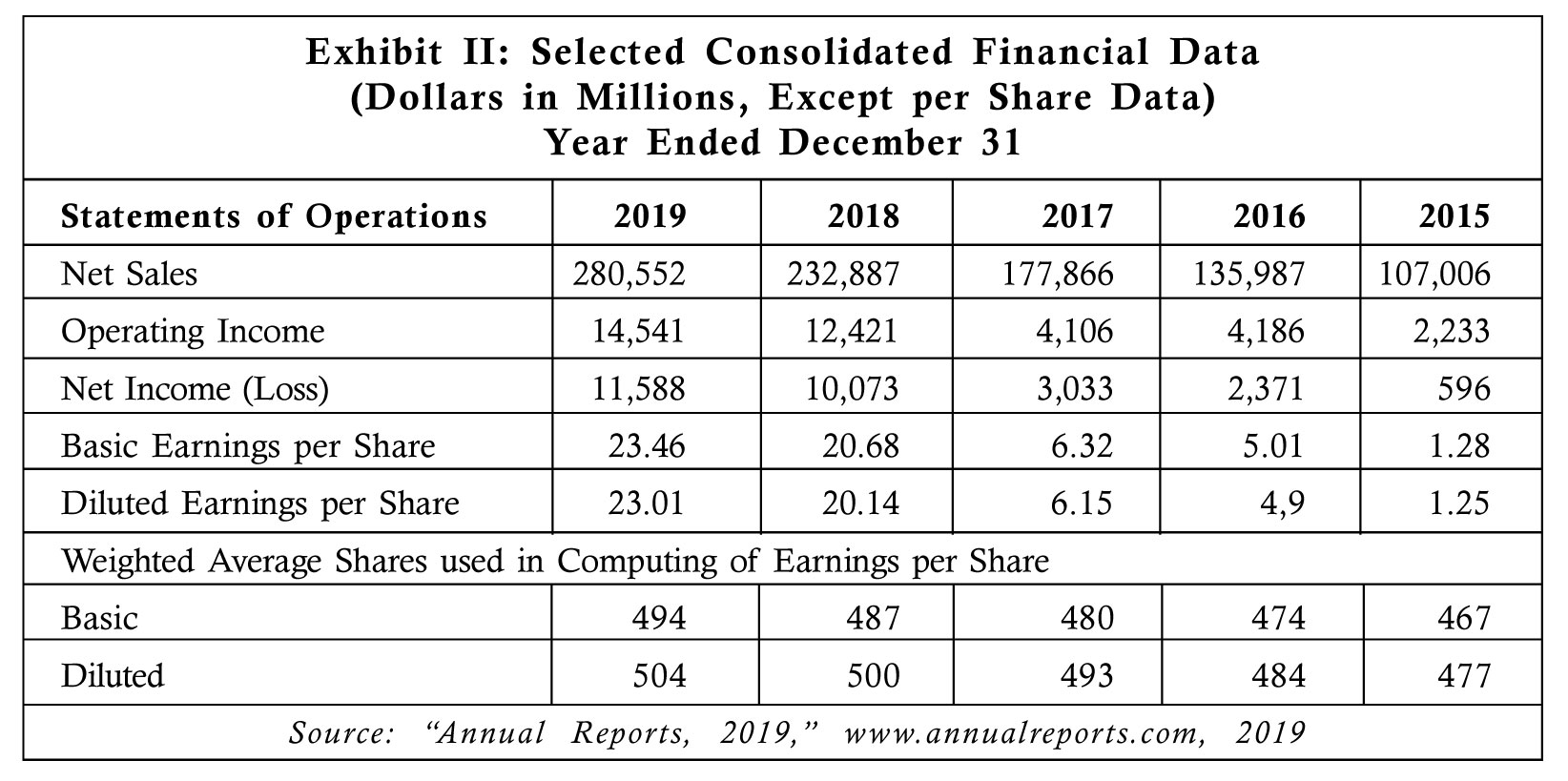
The Covid-19 Pandemic
The Covid-19 outbreak started in a wet market in Wuhan, which sold fish, birds, and both live and dead animals. Covid-19 was different from the Severe Acute Respiratory Syndrome (SARS) and Middle Eastern Respiratory Syndrome (MERS) in that, 80% of the people affected by it reported only a mild infection. However, many people carried the disease without displaying any symptoms, which made it difficult to control its spread. Covid-19 was known to spread via droplets when an infected person coughed or sneezed. When others touched the surfaces on which the droplets had landed with their hands, they spread the virus further. People could catch the virus if they touched their eyes, nose, or mouth with their infected hands. The single most important thing that people could do to protect themselves from the virus was to clean their hands by washing them frequently with soap and water or using a hand sanitizer.
On March 11, 2020, the World Health Organization (WHO), the international public health agency of the United Nations, stated that due to the rapid increase in the number of cases outside China?over 118,000 Covid-19 cases in more than 110 countries and territories?Covid-19 could be characterized as a pandemic.10
While 80% of the people infected with Covid-19 showed mild symptoms such as cold and flu, around 14% displayed symptoms of pneumonia and shortness of breath. Around
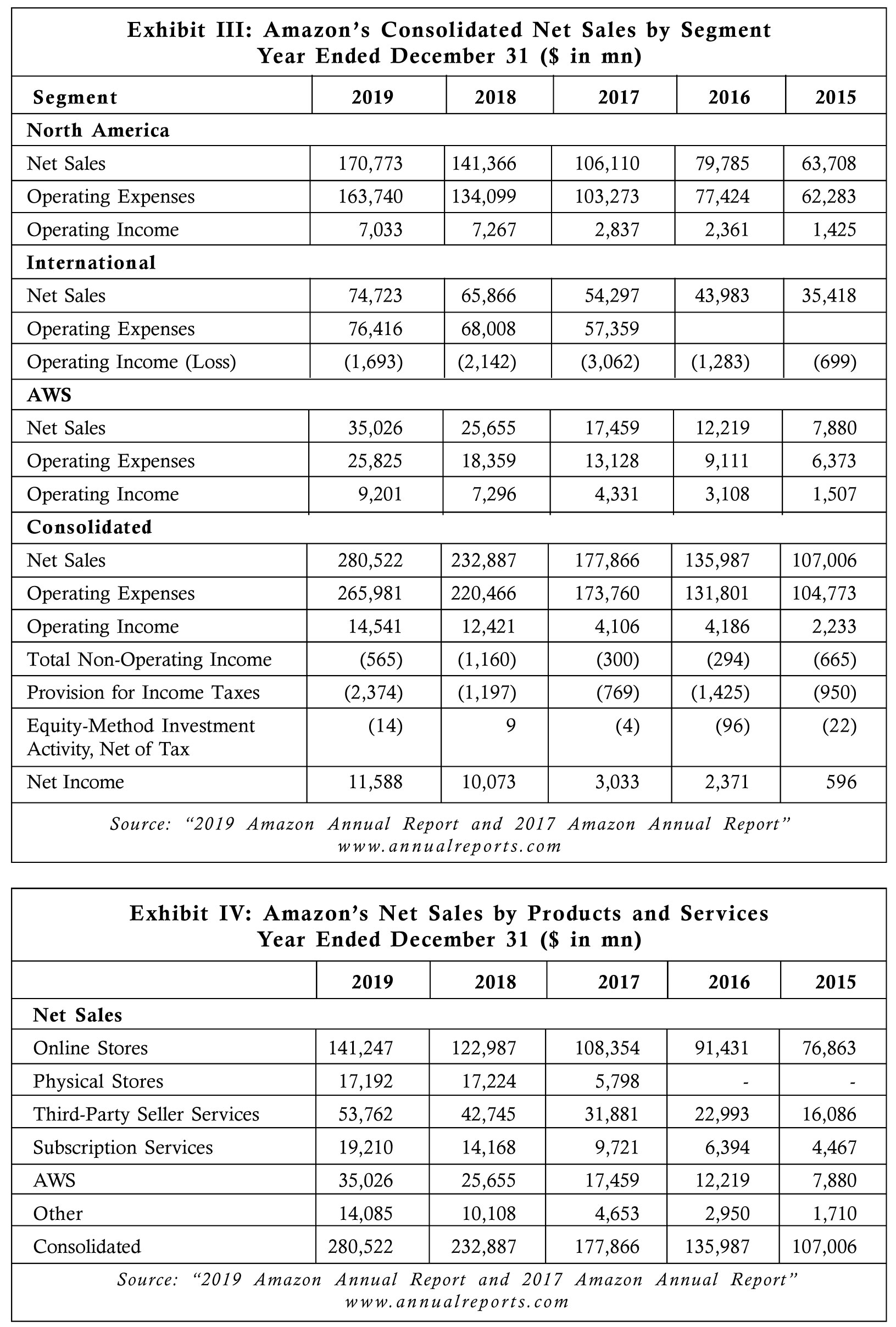
5% of the patients suffered from septic shock, respiratory failure and multiple organ failure, according to data released by the Chinese authorities.11
Since there was no specific treatment for Covid-19, doctors were trialling existing drugs that were used in the treatment of Ebola, HIV and malaria. Though the early results were promising, doctors could not be certain whether the drugs were effective until full clinical trials were concluded. A vaccine for Covid-19 was also not in sight. In mid-April 2020, the WHO said development of a vaccine for the Covid-19 might take 12 months or longer.
According to reference website providing counters and real-time statistics Worldometer, as of May 27, 2020, there were more than 5.6 million confirmed Covid-19 cases worldwide with 351,654 deaths (see Exhibit V for Covid-19 statistics for top 15 countries).12
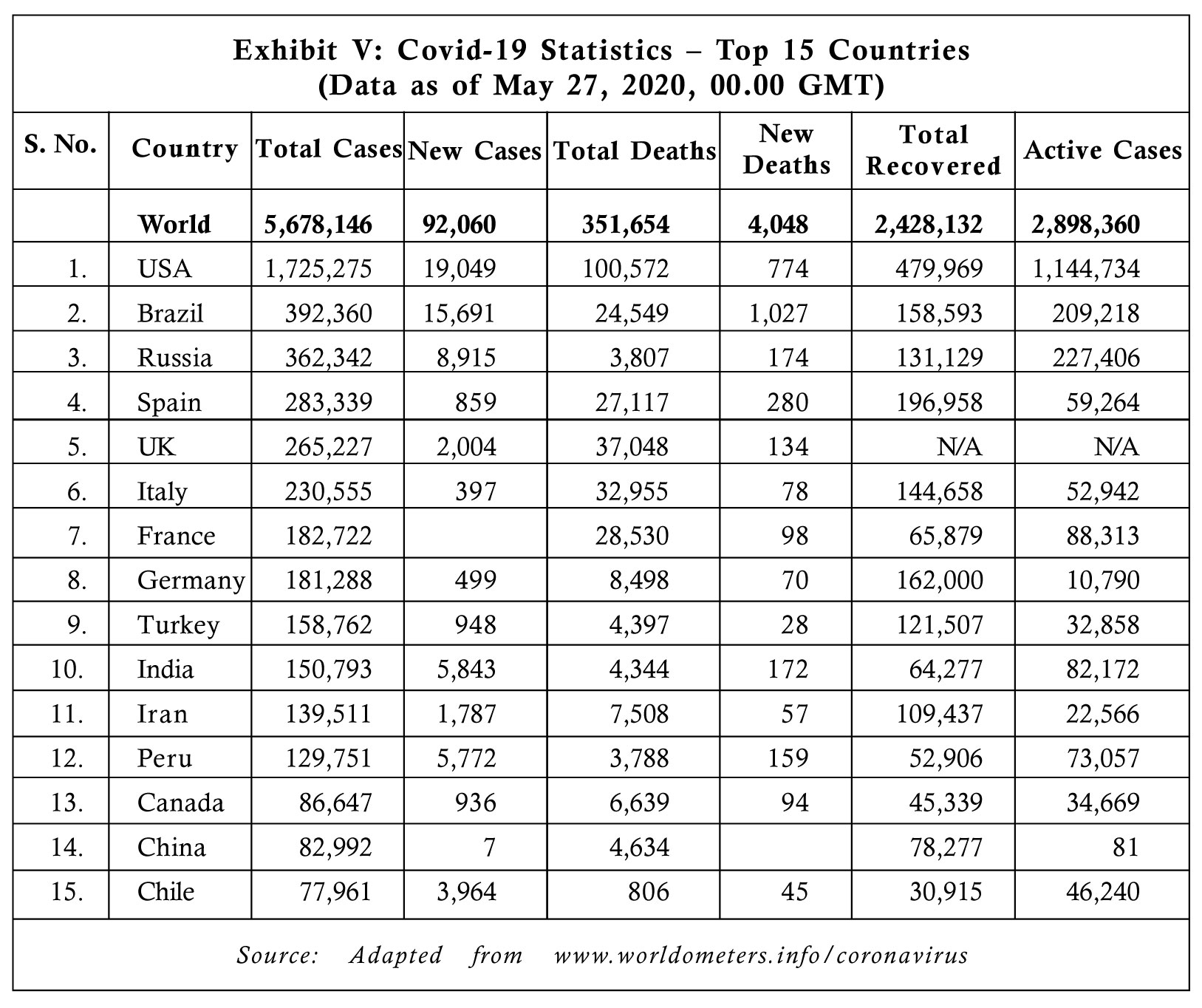
With no treatment options in sight, governments across the world were relying mostly on social distancing to arrest the spread of the disease. Many governments had imposed lockdowns, only allowing essential businesses to operate. This had led to massive disruptions in business. Analysts expected the retail business to be hit hard by the pandemic, as high selling items such as nonessentials like toys and electronic equipment could not be sold and only the sale of essentials was allowed. Thus, many department store chains and other "nonessential" retailers were forced to close down due to the pandemic. The store closures were expected to deliver a huge blow to cash reserves and the 16 million people the retail industry employed. According to American daily newspaper Washington Post, the week ending March 2020 witnessed around 1 million retail workers being furloughed from major retailing brands such as Macy's, Gap, Kohl's, L Brands, and JC Penney. Deborah Weinswig (Weinswig), chief executive at research and advisory firm Coresight Research, predicted that around 15,000 retail stores would close down permanently by the end of 2020, marking a 60% increase from store closures in 2019.13,14
Strategy During Covid-19 Pandemic
From the end of the late 1990s till 2020, Amazon invested tens of billions of dollars in building and developing its fulfilment network. The investment led to the retailer touting the superiority of its fulfilment abilities and to its becoming the first among online retailers to roll out same-day and next-day e-commerce deliveries. However, free delivery and rapid delivery came at a cost for Amazon. In 2014, free shipping led to Amazon incurring costs of more than $4.2 bn.15 Thus, in 2015, the retailer began expanding its role in delivery in a bid to reduce its operating costs and dependence on external providers. In 2016, Amazon bought the remaining 75% stake of the France-based delivery company Colis Privei in a bid to focus on fulfilment in deliveries. The retailer's investments in logistics included electric-powered delivery vans, sidewalk robots, drones, etc. Its fulfilment network coupled with its logistics ability led to Amazon developing a massive e-commerce infrastructure.
Amazon's e-commerce infrastructure became crucial in early March 2020 when the retailer experienced a surge in customer demand for essentials and other household staples such as groceries, health and personal care, and home office supplies. At the same time, the retailing giant witnessed lower demand for items such as shoe, apparel, and wireless products. The huge spike for online orders for essentials created major challenges in the e-commerce giant's operations network, its seller community and its suppliers. Consequently, Amazon prepared itself to handle the crisis.
The retailer started with the implementation of several safety protocols for its warehouse workers, drivers of its vehicles, and delivery executives fulfilling the orders. According to the company, 150 significant process changes were made in its operations network and whole foods market stores to help teams stay healthy with the company conducting daily audits to ensure compliance.16
Temperature screening and distribution of masks and gloves were done across its US and European operations network and its whole foods market stores. The retailer ensured that regular sanitization of door handles, touch screens, handrails and other frequently touched surfaces was taking place across all its fulfilment centers. At some of its whole foods stores, where pickup of orders was allowed, the retailer ensured social distancing, restricting the number of employees and consumers based on the store size. The store hours were adjusted to give its workers time to sanitize the stores and restock shelves. Disinfectant was also sprayed across all its networks in a bid to supplement the enhanced cleaning measures already in place. Some changes were also made across its stores wherein personal reusable containers were not allowed and seating areas were temporarily made unavailable.
The company had a practice of hiring 120,000 seasonal employees to handle extra workloads during the holidays.17 Commenting on its initiatives to keep its workers safe during the pandemic, Brian Olsavsky (Olsavsky), CFO at Amazon, said that the company had the ability to gear up for spikes in demand during prime day and the holiday season, as it prepared for these months in advance. But the demand spurred by Covid-19 left it with no time for such preparations. "We took quick action to react to the higher order levels while continuing to provide for the safety of our workforce. We established rigorous safety and cleaning protocols, including maintaining six-foot social distancing, procuring 100 million masks, tens of millions of gloves and wipes and other cleaning supplies. We began requiring temperature checks across our operations network. In our whole foods stores, we added plexiglass barriers between cashiers and customers and reserved special hours for senior customers to shop. We temporarily raised wages and overtime premia, we funded a new Amazon Relief Fund and we allowed employees to take unpaid time off at their discretion,"18 Olsavsky said.
Though Amazon had a huge infrastructure to handle the demand from consumers, it faced difficulties in fulfilling orders. Thus, to tackle the increased demand, Amazon expanded its e-grocery delivery capacity by 60%. Since this was not enough, in mid-April 2020, it announced that it would put customers on a waiting list and invite new customers to shop every week. According to Stephenie Landry (Landry), Vice President of grocery at Amazon, "To help, in the coming weeks, we will launch a new feature that will allow customers to secure time to shop. This feature will give delivery customers a virtual place in line' and will allow us to distribute the delivery windows on a first-come, first-served basis. Simultaneously, we will continue to add capacity as swiftly as possible."19 The retailer also adjusted store hours for some of its whole foods store locations in a bid to exclusively focus on fulfilling online grocery orders. According to Landry, "We are releasing delivery windows throughout the day and have made it easier for customers to see when the next delivery window is available by including it on the homepages of Amazon Fresh and Whole Foods Market."20
In April 2020, the retailer increased pick up from its whole foods stores from 80 to over 150 stores to help consumers shop for groceries and other essentials. In addition to this, Amazon opened the Woodland Hills, California grocery store as a temporary online-only store, focused exclusively on fulfilling grocery delivery orders.
Amazon also extended its support to the most vulnerable communities during this pandemic by reserving the first hour of grocery pickup at Whole Foods Market stores in the US for customers who were 60 years and older, those who had disabilities and those whom the US-based national public health institute Center for Disease Control and Prevention (CDC) defined as high risk. These customers had to go online to amazon.com/wholefoods, select "Pickup," and set up their cart. After they checked out, they could select the first pickup window of the day reserved for at-risk customers. In addition to this, all Whole Foods Market stores were open to serve this group of consumers an hour before opening to the public.
While increasing capacity through several initiatives, Amazon had hired 175,000 people by the end of April 2020 for fulfilment and delivery of orders to consumers. Since the workers were reporting to work during the pandemic, the retailer had increased minimum wage by $2 an hour from $17 an hour for workers, with overtime doubling that to $34 an hour.21 There was a similar $2/h, GBP2/h and ?2/h hike in Canada, the UK, and other European countries respectively. The company said that increased pay for its hourly employees and partners during COVID-19 would add up to nearly
$700 mn through May 16, 2020.22
Other Initiatives
Some scientists, program managers, procurement specialists, and software engineers at Amazon were shifted from their regular jobs to form a dedicated team working to build incremental Covid-19 testing capacity. The team was building its first lab and had started a pilot to test front-line employees.
In March 2020, Amazon set up a $25 mn Amazon Relief Fund to support its delivery service partners and drivers, seasonal employees, and Amazon Flexj participants who were working for it during these challenging times.23 The retailer planned to offer grants of up to two-weeks of pay to its workers if they were diagnosed with Covid-19 or were under quarantine by Amazon or the government. In addition to this, the retailer gave its hourly workers unlimited unpaid time off till the end of March 2020 if they chose to remain at home. In April 2020, the fund was extended to Amazon India for providing support amidst the pandemic.
In April 2020, Amazon started a non-profit store for supplying front-line medical workers and others fighting the Covid-19 pandemic with supplies such as surgical masks, face shields, sanitizers, digital thermometers, exam gloves, and ventilators. Amazon called its store 'Covid-19 supplies' and made it accessible only to government agencies and accredited medical professionals. The store was accessible to hospitals, nursing facilities, physicians' offices, federal agencies, ambulance crews, and the police and fire departments. Since the equipment was in very short supply in the US because of the pandemic, Amazon set up the store to keep up with the demand.
Amazon also limited the sale of N95 masks and other medical equipment only to government entities and hospitals. It also eliminated the commission it usually charged for those sales, encouraging merchants to source these goods to sell on Amazon.
In addition to these initiatives, Amazon committed ?21 mn to relief organizations in Europe affected by Covid-19. The retailer used its Amazon Flex drivers to enable food banks to deliver 427,000 pounds of groceries for 336,000 meals. Amazon also entered into a partnership with a Seattle-based catering company for distributing 73,000 meals to 2,700 elderly and medically vulnerable residents. The retailer also donated $100 mn to Feeding America's Covid-19 Response Fund.24
Amazon Gains
As of March 2020, Amazon accounted for 40% of online sales in the US, according to online research firm e-Marketer. Analysts felt that the Covid-19 pandemic would help the retailer in gaining more sales as most of the consumers were forced to stay indoors and ordered online.
The demand for essentials on Amazon was so huge that for the month of March 2020, the website traffic on Amazon surged to 2.54 billion visitors, an increase of 65% from the same period of 2019, according to American media measurement and analytics company Comscore.25 This was followed by a report in the British daily newspaper The Guardian that stated that consumers were spending $11,000 every second buying products or services on the company's e-commerce platform for the month of March 2020.26 Amazon's success could also be seen by the fact that Amazon fresh and whole foods delivery sales increased by more than 400% year-over-year during the week beginning March 16, 2020, according to estimates by California-based data analytics firm second measure.
In April 2020, the retailer observed that its Prime subscribersk had surpassed the 150 million mark.27 On April 14, 2020, with Amazon shares reaching a record high of $2,280, the value of the company went up to $1.4 tn (see Exhibit VI for Amazon's Stock Chart).28
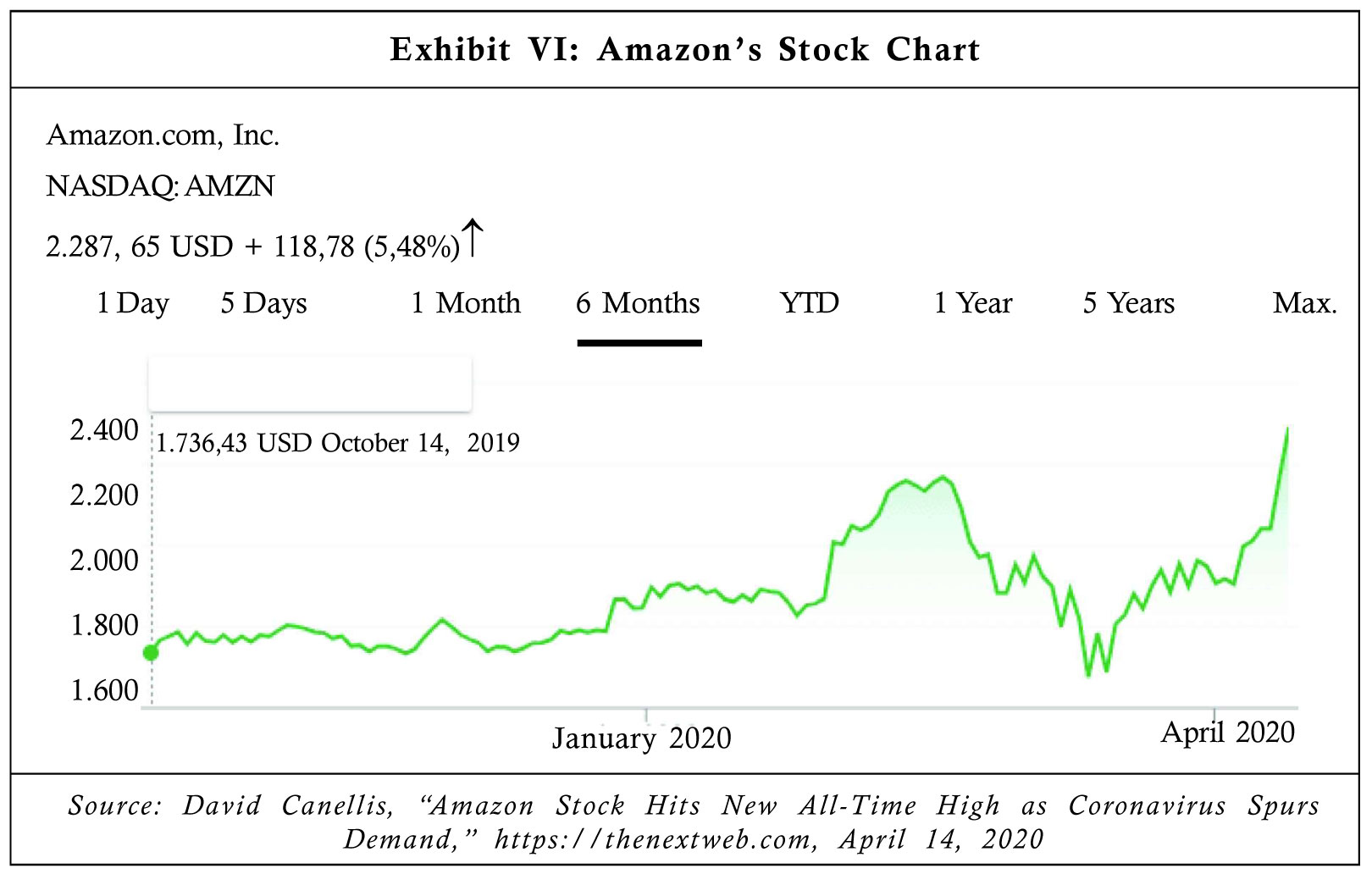
Analysts opined that when foot traffic at non-grocery retail stores had declined by 97% in the last two weeks of March 2020, Amazon had seen consumer spending increasing by 35% for the same period. The surge in demand was attributed to Amazon's ability to hire and train 80,000 new workers within a few weeks of the outbreak.29
Amazon reported its first quarter 2020 sales of $75.4 bn for the month ended April 30, 2020. The retailer's sales in North America increased by 29% to $46.127 bn for quarter 1 (Q1) of 2020 from $35.812 bn for Q1 of 2019. The company's cloud-computing arm, AWS, reported an increase in sales of 32.8% to $10.219 bn for Q1 of 2020 from $7.696 bn for Q1 of 2019 (see Exhibit VII for Amazon's net sales growth by segment for four quarters of 2019 and Q1 of 2020). During the Covid-19 pandemic, AWS helped schools worldwide transit to online learning through EdTechl customers and partners. According to Amazon, "In India, EdTech startup Impartus is launching virtual
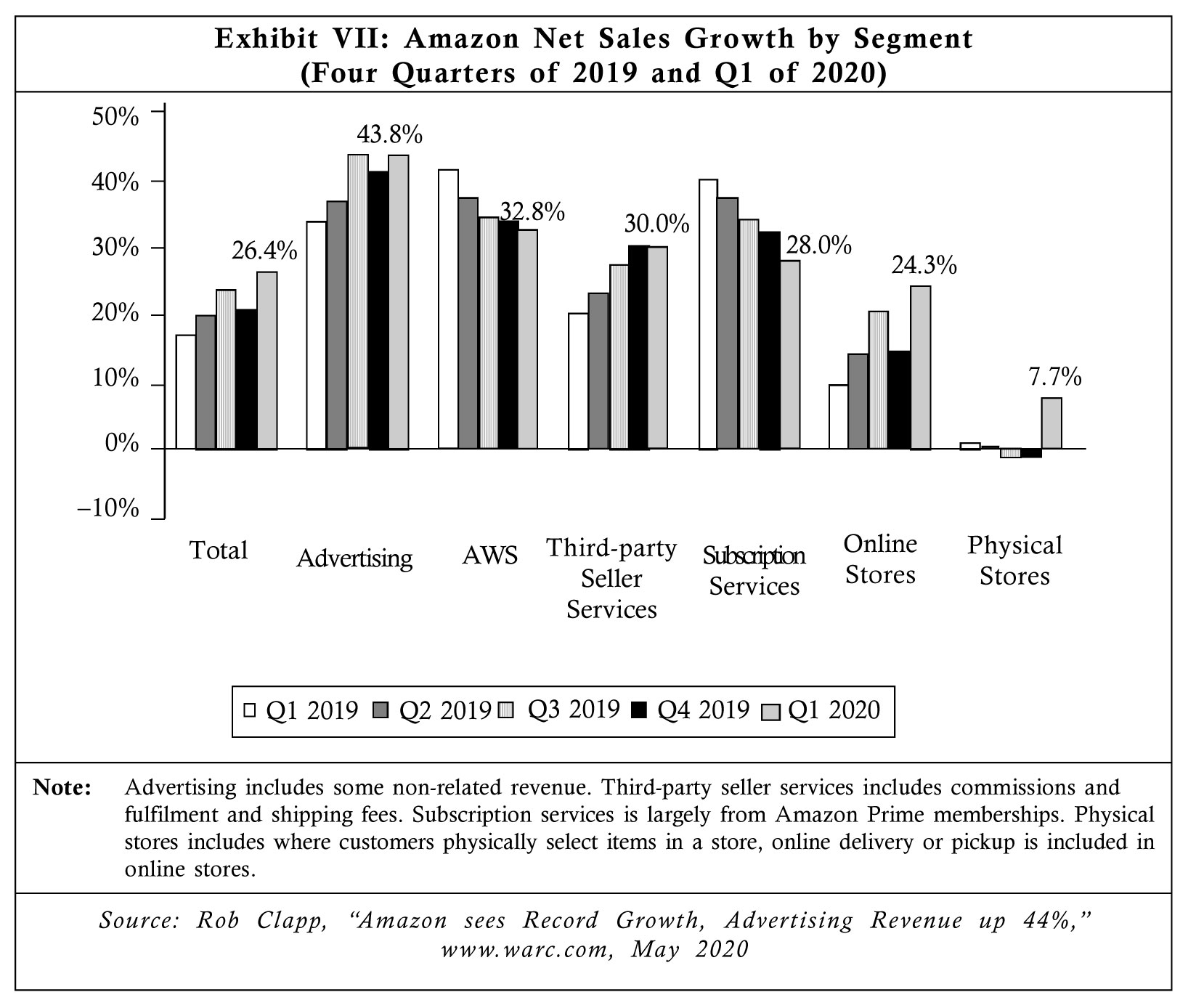
classrooms for more than 530,000 students?the online equivalent of 13,000 physical classrooms."30
Analysts expected sales at Amazon to increase as more stores closed and shoppers turned to online stores for buying groceries and other products. According to e-Marketer principal analyst Andrew Lipsman, "Amazon's huge topline acceleration is not a complete surprise amid the pandemic's shifting consumer spending in favor of e-commerce and online grocery."31
Some analysts felt that Amazon's online stores had an edge over brick and mortar stores as there were more stringent rules for physical stores during the pandemic. According to Christy Campbell (Campbell), a partner at the law firm Duane Morris, physical stores had to deal with complex rules that varied "state to state and minute to minute." Campbell added, "Amazon does not have to think about these different rules from state to state that are constantly changing. That is where online retailers are at a real advantage."32
Supply Chain Issues
The Covid-19 pandemic and the lockdown led to an unprecedented increase in demand at Amazon for household goods, groceries and medical supplies such as hand sanitizers and face masks as consumers shifted to online stores rather than taking the risk of getting infected by Covid-19 at physical stores. But the demand placed a huge stress on the e-commerce giant's supply chain. Amazon operated on the 'Just-in-time' delivery principle, i.e., its warehouses did not keep a lot of stock of any product. As soon as the products were sold, the retailing giant's logistics were in place to ship more items. But the lockdown led to panic buying by consumers, thereby depleting the inventory before manufacturers could restock the items.
The shipping delays were also attributed to factory closures in China, the epicenter of Covid-19 due to mass quarantines. From January 2020 to February 2020, the industrial output in China fell 13.5% below normal rates of production.33 This disrupted the supply chains of companies across the world, including merchants selling on Amazon's marketplace who accounted for half of Amazon's retail volume, leading to a delay in shipments. To manage the impact of Covid-19, Amazon suggested to its sellers that they cancel previous orders they had not been able to fulfil and put their businesses in 'vacation status', which would protect their listings from going down in search results by its ranking algorithms. The company also removed one million offers from its stores due to Covid-based price gouging and suspended more than 10,000 selling accounts globally for violating its fair-pricing policies.
To understand vendor capacity, in February 2020, Amazon sent out surveys to sellers in Europe and China for current and future orders. The survey required the sellers to give their factory location, whether it was running at full capacity, whether there were any manufacturing delays, and whether they expected any delays in production in the following weeks. James Thomson (Thomson), a partner at Amazon's marketing agency and consulting company Buy Box Experts and former business head of Amazon services, believed that the majority of delays were not related to just the sellers; delivery friction was slowing things down. According to Thomson, "Unless a retailer has its own last-mile delivery capability, I do not see it being able to do much other than setting expectations with its customers that delivery times will be longer. Even a company like Amazon cannot keep up?and it owns thousands of last-mile delivery trucks."34
While Amazon was grappling with shipment delays, some customers complained about delivery slots being unavailable due to the overwhelming number of grocery deliveries by Amazon amidst the pandemic. To cater to the demanding consumers, Amazon reshuffled its logistics placing priority on delivering essentials but this damaged its ability to meet the demand for nonessentials such as electronics, toys and games, and home sports equipment?all of which were needed by parents and children stuck at home due to lockdowns. Some consumers also complained that Amazon could not keep up its brand promise, i.e., faster delivery. The retailer's loyalty program, Amazon Prime, which had enticed consumers with the promise of free two-day delivery, was taking up a month to deliver the products to consumers. Amazon Fresh, which delivered groceries and produce on the same day, the order was placed was also delaying shipments.
Stakeholder Tension
To add to its woes, the e-commerce giant faced several protests from workers for keeping its warehouses open for delivery. Employees complained that Amazon did not notify them about the increasing number of Covid-19 cases at the workplace. They also raised concerns over the retailer not supplying enough cleaning material for sanitizing its warehouses and for its refusing to pay Covid-19-related sick leave. Some of them complained that at the Amazon facilities where there was at least one Covid-19 positive worker, the facility was not closed for deep cleaning and physical distancing was failing as hundreds of workers could be working in the same building during the shift. Bezos acknowledged that Amazon was suffering from shortage of supplies to keep its employees safe. In a letter to its employees, he said, "We have placed purchase orders for millions of face masks we want to give to our employees and contractors who cannot work from home, but very few of those orders have been filled. When our turn for masks comes, our first priority will be getting them in the hands of our employees and partners working to get essential products to people."35
In March 2020, a group of four US senators, including democratic presidential candidate Bernie Sanders, sent a letter to Bezos seeking his response on how Amazon was keeping its warehouse workers safe amidst the pandemic. Amazon warehouses had already come under the scrutiny of the media and regulators since 2017 for its allegedly stringent working conditions. The letter said, "The virus that causes Covid-19 can live for up to 24 h on cardboard and up to three days on plastic and stainless steel. That means that Americans who are taking every precaution, staying home and practicing social distancing, might risk getting infected with Covid-19 because of Amazon's decision to prioritize efficiency and profits over the safety and well-being of its workforce."36
Calling the accusations, "simply unfounded" Amazon responded to the letter saying, "Our employees are heroes fighting for their communities and helping people get critical items they need in this crisis. Like all businesses grappling with the ongoing Coronavirus pandemic, it is not easy as supplies are limited, but we are working hard to keep employees safe while serving communities and the most vulnerable. We have taken extreme measures to keep people safe, tripling down on deep cleaning, procuring safety supplies that are available, and changing processes to ensure those in our buildings are keeping safe distances."37
Despite facing criticism from several quarters, Amazon continued with its delivery due to surging demand. By the end of March 2020, Covid-19 positive cases were confirmed at six of its facilities. The first case was reported at its warehouse in Queens New York in March 2020. This was followed by cases being reported in Kentucky, Florida, Texas, Michigan and Oklahoma. In another instance, two Amazon workers at the Seattle headquarters tested positive for Covid-19. Subsequently, the Amazon management sent the day-shift workers home so that the sorting facility, known as DBK1, at Queens, New York, could be disinfected. According to an Amazon spokesperson, "We are supporting the individual who is now in quarantine. In addition to our enhanced daily deep cleaning, we have temporarily closed the Queens delivery station for additional sanitation and have sent associates home with full pay."38 By mid-March 2020, attendance at Amazon facilities had fallen by 30% as some of the workers did not wish to risk their lives for a paycheck, in addition to some of them being impacted by Covid-19.39
On March 31, 2020, workers at Amazon started protesting against the retailer, demanding the safety of workers. Around 50 to 60 workers in the New York borough of Staten Island staged a walkout demanding the facility be shut down and cleaned after a worker tested positive for Covid-19. According to Amazon warehouse worker, Christian Smalls (Smalls), "There are positive cases working in these buildings infecting thousands."40 Amazon responded by saying that Smalls' statements were misleading and he was supposed to be under quarantine and was violating the measures taken by the retailer. Amazon fired Smalls after the protest, for which it faced flak from New York state attorney general Letitia James (James) who called Smalls' dismissal "disgraceful". James pointed out that the law protected employees' right to protest. She asked the National Labor Relations Board to investigate the incident at Amazon. In May 2020, a group of senators wrote a letter to Amazon asking the retailer about its "policies for discipline and termination regarding workers who raise health and safety concerns." In the letter, the senators cited four employees who had been terminated allegedly after they criticized Amazon's response to the Covid-19 pandemic. They also pointed out that more than 100 Amazon workers had tested positive and at least three had passed away due to Covid-19. The letter also stated that Amazon's safety responses such as closing down its warehouses for 48 h for deep cleaning after the employees had tested positive were insufficient. An Amazon spokesperson said, "These individuals were not terminated for talking publicly about working conditions or safety, but rather, for violating?often repeatedly?policies, such as intimidation, physical distancing and more. We support every employee's right to criticize or protest their employer's working conditions, but that does not come with blanket immunity against any and all internal policies."41
In mid-March 2020, Amazon faced protests from workers in France as the retailer continued with online deliveries even after retailers in France were ordered to deliver only groceries and essentials. Since Amazon did not take any action, around 250 to 300 workers staged a strike at Saran outside Orleans, a city in southern Paris. Amazon, however, stated that it adhered to the sanitary guidelines and was prioritizing only delivery of essentials (household staples, medical supplies and other critical products). Julien Vincent, an Amazon logistics worker for France CDFTm union, stated that around 30% to 40% of the employees in France had dropped out of work due to fear of contracting the virus.42
On April 14, 2020, a French court ruled that Amazon should shut down six of its distribution centers in France as it had not done enough to protect workers in its warehouses from Covid-19. Amazon said that it had closed down in the country because of the ambiguity in the order which did not specify which goods were 'essential'. By closing down, the retailer also avoided the risk of being fined ?1 mn per day in the event of a breach.43
Even as Amazon was facing a backlash from several quarters, the retailer reported on April 14, 2020, that a member of its management team in Hawthorne, California, had died of Covid-19.44
In response to the criticisms that it was not looking after the safety of its workers during the pandemic, the e-commerce giant installed thermal cameras at its warehouses across the world in April 2020 for screening workers for Covid-19 symptoms. The cameras helped in detecting fever by comparing the person's body temperature with that of the surroundings. In addition to this, Amazon maintained that it followed all cleanliness protocols such as sanitization of handrails, door handles and other frequently touched surfaces. It purchased 100 million face masks for its employees and 1,000 thermal cameras and 31,000 thermometers to conduct mandatory daily temperature checks for the employees and support staff.45
Amazon also said that the workers affected by Covid-19 were under quarantine and were receiving medical attention. The workers were paid full salary during the period and other workers who had come into contact with them were also placed under quarantine for two weeks with full salary, it said.
Looking Ahead
Bezos said that while the retailer had had a tough Q1 of 2020, it would suffer losses in Q2 of 2020 as it was planning to spend around $4 bn on Covid-19 related costs such as increasing PPEs for workers and more intense cleaning of warehouses, and nearly $300 mn on developing internal Covid-19 testing capabilities.46 This was in addition to the $700 mn, it had incurred globally in in April 2020 in extra wages for its hourly warehouse workforce and delivery contractors.
Some analysts believed that despite Amazon incurring huge costs, the pandemic would work in its favor, if the e-commerce giant used the outbreak as an opportunity to integrate itself into the lives of old as well as new consumers. According to Christopher Rossbach, chief investment officer at J. Stern & Co.n, "The crisis will hopefully be short-lived, but the impact on Amazon could be profound over the long-term with over 150 [million] Prime members now active. Habits will form, and many of these people will shop more using Amazon in the future."47
On the other hand, some critics felt that the demand for brick and mortar sales could rise again as people would want to go out after being cooped up at home for a long time due to the lockdowns. It remained to be seen whether Amazon would be able to keep up with the momentum when the Covid-19 pandemic ended.
End Notes
- "AWS and Prime Emerge the Biggest Winners in Amazon's (AMZN) COVID-19-hued First Quarter," https://news.alphastreet.com, May 1, 2020.
- Noel Randewich, "Amazon is Wall Street's Biggest Winner from Coronavirus," https://in.reuters.com, April 30, 2020.
- Dominic Rushe and Michael Sainato, "Amazon Posts $75 bn First-quarter Revenues but Expects to Spend $4 bn in Covid-19 Costs," www.theguardian.com, April 30, 2020.
- Rupert Neate, "Amazon Reaps $11,000-a-Second Coronavirus Lockdown Bonanza," www.theguardian. com, April 15, 2020.
- "Coronavirus Pandemic Brings Fortunes to Amazon ? and Headaches Too," www.newindian express. com, April 29, 2020.
- JP Mangalinandan, "Can Amazon Handle the Coronavirus Pressure?", www.protocol.com, March 22, 2020.
- "Amazon has Hired 175,000 Additional People," https://blog.aboutamazon.com, April 30, 2020.
- Erik Sherman, "20 Years of Amazon's Expansive Evolution," www.cbsnews.com, July 15, 2015.
- "Our Global Offices," www.aboutamazon.com, 2020.
- Jamie Ducharme, "World Health Organization Declares COVID-19 a 'Pandemic.' Here's What that Means," https://time.com, March 11, 2020.
- Sarah Newey and Anne Gulland, "What is Coronavirus, How Did it Start and How Big Could it Get?" www.telegraph.co.uk, April 10, 2020.
- "Global Coronavirus Cases Top Two Million: Johns Hopkins," www.cgtn.com, April 15, 2020.
- Jason Del Rey, "Amazon Was Already Powerful. The Coronavirus Pandemic Cleared the Way to Dominance," www.vox.com, April 10, 2020.
- Khristopher J Brooks, "Coronavirus Could Cause a Record 15,000 Stores to Close in 2020," www.cbsnews.com, March 25, 2020.
- Zvi Schreiber, "Amazon Logistics Services ? The Future of Logistics?" www.supplychain247.com, February 2, 2016.
- "Amazon.Com Announces First Quarter Results," https://s2.q4cdn.com, April 30, 2020.
- Michael Sainato, "Exploited Amazon Workers Need a Union. When Will They Get One?" www.the guardian.com, July 8, 2018
- Russell Redman, "Amazon's Physical Store Sales Rebound in Q1 amid Pandemic," www.supermarket news.com, May 1, 2020.
- James Melton, "Grocery Retailers Adapt as Coronavirus upends Shopping Patterns," www.digital commerce360.com, April 24, 2020.
- "Amazon to Start Online 'Queues' for New Customers as Demand Surges," https://telanganatoday.com, April 13, 2020.
- Jeremy Bowman, "4 Takeaways from Jeff Bezos' Annual Shareholder Letter," www.fool.com, April 19, 2020.
- "Amazon.Com Announces First Quarter Results," https://s2.q4cdn.com, April 30, 2020.
- Beth Galetti, "Covid-19 Update: More Ways Amazon is Supporting Employees and Contractors," https://blog.aboutamazon.com, March 11, 2020.
- Patrick Moorhead, "Amazon Neither Winning or Profiting from COVID-19," www.forbes.com, May 4, 2020.
- Leticia Miranda, "Amazon Has Been Indispensable during the Pandemic?But it's Clear Who Really Wins," www.nbcnews.com, May 1, 2020.
- Rupert Neate, "Amazon Reaps $11,000-a-second Coronavirus Lockdown Bonanza," www.theguardian. com, April 15, 2020.
- Leo Sun, "The Covid-19 Crisis Can't Sink these 3 E-Commerce Stocks," www.fool.com, April 23, 2020.
- Rupert Neate, "Amazon Reaps $11,000-a-second Coronavirus Lockdown Bonanza," www.theguardian. com, April 15, 2020.
- Howard Yu, "How Apple and Amazon are Winning through the Covid-19 Fallout," www.forbes.com, May 1, 2020.
- "At Over $40 Billion Annual Run Rate, Amazon Web Services Growing Faster than Ever," www.indiatvnews.com, May 3, 2020.
- Don Davis, "Amazon's North America Sales Surge 29% in Q1 as Coronavirus Drives Demand," www.digitalcommerce360.com, April 30, 2020.
- Spencer Soper, "Amazon is Poised to Emerge from the Pandemic Stronger than Ever," www.bloomberg quint.com, April 17, 2020.
- Wade Shepard, "COVID-19 Undermines China's Run as the World's Factory, but Beijing has a Plan," www.forbes.com, March 26, 2020.
- Rima Katts, "Supply Chains are Strained as the Pandemic Causes a Surge in Online Orders," www.emarketer.com, April 23, 2020.
- "A Message from Our CEO and Founder," https://blog.aboutamazon.com, March 21, 2020.
- Jay Peters, "US Senators Demand Amazon Answer Questions about Warehouse Worker Safety," www.theverge.com, March 20, 2020.
- Taylor Soper, "Amazon Calls Accusations 'Simply Unfounded' after Senators Question Warehouse Worker Protection," www.geekwire.com, March 20, 2020.
- Chhaivianshikha Singh, "Amazon Confirms First Case of COVID-19 in New York Warehouse," www.news18.com, March 19, 2020.
- Karen Weise and Kate Conger, "Gaps in Amazon's Response as Virus Spreads to more Than 50 Warehouses," www.bizjournals.com, April 6, 2020.
- "Amazon Fires Employee Who Said Coronavirus Cases Working in Warehouses," www.ndtv.com, March 31, 2020.
- Christine Fisher, "US Senators Ask Amazon Why it Keeps Firing COVID-19 Whistleblowers," www.engadget.com, May 7, 2020.
- Mourad Guichard, Caroline Pailliez, "French Amazon Workers Protest in Coronavirus Pushback," www.reuters.com, March 18, 2020.
- Melissa Heikkil? and Nicholas Vinocur, "Amazon Shutdown in France puts Squeeze on Macron Government," www.politico.eu, April 19, 2020.
- Rachel Sandler, "First Known Amazon Warehouse Worker Dies from Covid-19," www.forbes.com, April 14, 2020.
- "Amazon.Com Announces First Quarter Results," https://s2.q4cdn.com, April 30, 2020.
- "Amazon sees Possible Q2 Loss as it Forecasts $4 Billion in Covid-19-related Costs," https://tech. economictimes.indiatimes.com, May 1, 2020.
- Irina Ivanova, "Amazon Makes $10,000 per Second as Shoppers Shelter in Place," www.winknews.com, May 1, 2020.